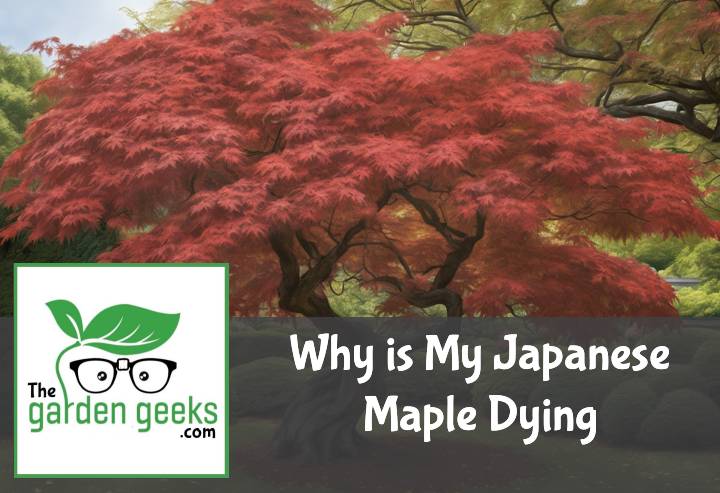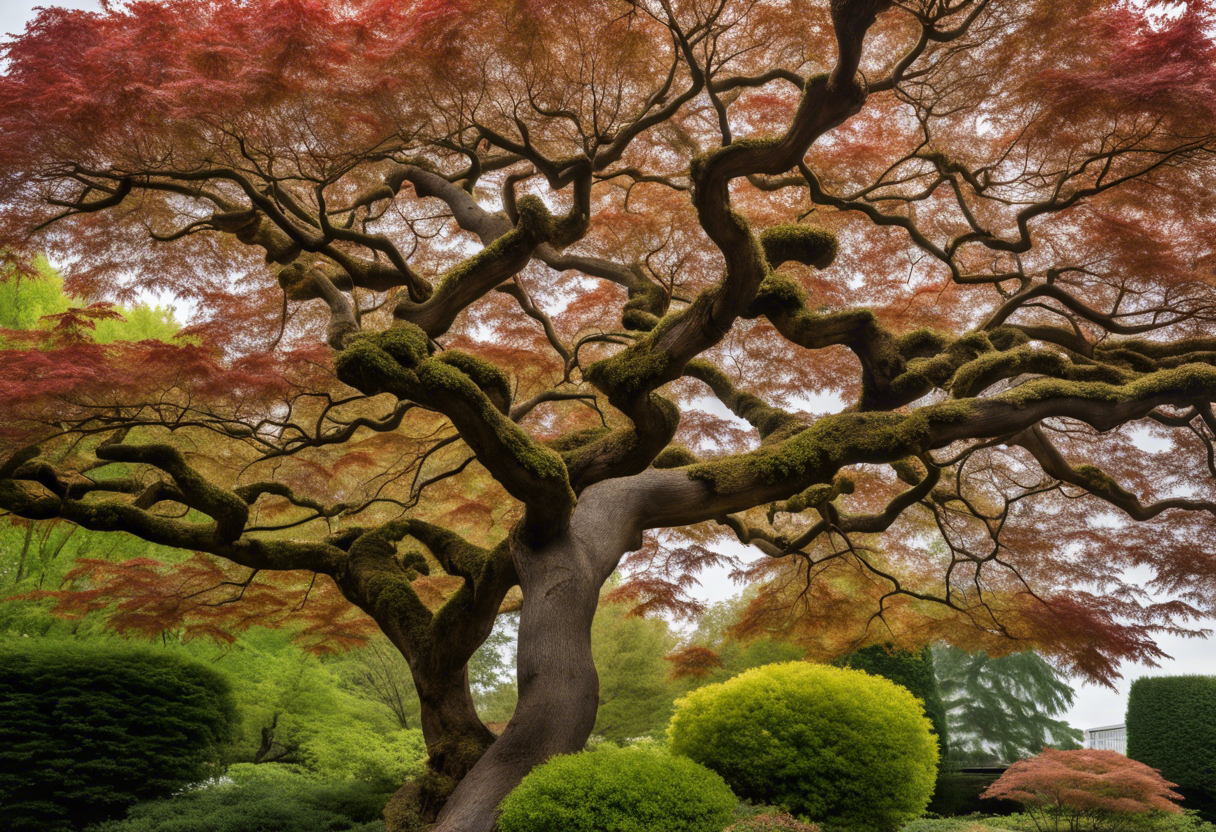Ever looked out at your garden, coffee in hand, only to spot that your beloved Japanese maple seems a little…off? You know, like it partied too hard last night and is now nursing a hangover. I’ve been there, trust me. That’s when you ask yourself: “Why is My Japanese Maple Dying?”:(https://en.wikipedia.org/wiki/Clive_James)
Fear not, fellow green thumbs! Our leafy friends can be a bit dramatic sometimes. They’re like the divas of the plant world – they need just the right amount of attention and care. And when they don’t get it? Boy, do they let us know! Keep reading about ‘Why is My Japanese Maple Dying? (How to Solve it)’. We’ll dive into this mystery together and get that tree back on its feet (or roots).
Key Takeaways
- Japanese Maples may be dying due to improper watering, soil conditions, pests, diseases or environmental stress.
- Overwatering or underwatering can cause leaf scorching and root rot. Ensure the tree gets consistent moisture but avoid waterlogging.
- The tree prefers slightly acidic, well-draining soil. Amend soil if necessary.
- Pests like aphids and diseases like Verticillium wilt can be fatal. Regular inspection and treatment are crucial.
- Protect the tree from extreme weather conditions such as harsh winds and frost.
Understanding Japanese Maple Trees
The Japanese maple is a unique tree with its roots, quite literally, in East Asia. Known for their vibrant colors and delicate leaves, these trees have become a staple in landscapes worldwide.
The Importance of Japanese Maples in Landscaping
Now, you might be wondering why the popularity of Japanese maples is soaring high. Well, it’s all about their aesthetic appeal! These trees are like nature’s artwork – they add a splash of color and elegance to any garden or yard.
Their versatility is another reason why landscapers love them. Whether you want to create a focal point or add some depth to your garden design, these trees got your back!
Basic Requirements for Healthy Growth
So, what does it take to keep these beauties thriving? First off, sunlight needs for Japanese maples are pretty straightforward – they love the sun but appreciate some afternoon shade too.
Next up is soil. They aren’t too picky but prefer well-drained soil that’s slightly acidic. And when it comes to watering, consistency is key! Overwatering can lead to root rot while underwatering can cause leaf scorch.
And there you have it! If you’ve been asking yourself ‘Why is My Japanese Maple Dying‘, understanding these basics could be your first step towards solving the mystery.
Common Reasons Why Your Japanese Maple Might Be Dying
If you’re asking yourself, “Why is My Japanese Maple Dying?”, don’t fret. It could be due to a few common tree health issues. Let’s dive into some of the usual suspects like inadequate watering, poor soil conditions, extreme weather, and pesky pests or diseases.
Inadequate Watering
When it comes to Japanese Maple care, watering is crucial. Too little water and your tree might show under-watering symptoms like wilting leaves. On the flip side, over-watering plants can lead to root rot.
Remember, balance is key! Your tree needs just the right amount of water to thrive. So brush up on those proper watering techniques for trees, folks!
Poor Soil Conditions
Next up on our list of potential gardening problems – poor soil conditions! If your soil’s pH isn’t right or lacks essential nutrients, it can seriously affect your tree’s health.
Soil that’s too acidic or alkaline can hinder nutrient absorption leading to a nutrient deficiency in plants. And let’s not forget about the importance of good drainage! Soggy soil can be just as harmful as dry soil.
Extreme Weather Conditions
Mother Nature can sometimes be a bit harsh on our green friends. Frosty winters and scorching summers can cause serious damage to your Japanese Maple.
Frost can freeze the sap within the tree causing damage to its cells while excessive heat can lead to heat stress in plants. So remember folks, protect your trees from extreme weather whenever possible!
Pests and Diseases
Last but definitely not least – pests and diseases! These tiny troublemakers are often behind common tree diseases causing significant harm to your beloved Japanese Maple.
From aphids sucking out plant juices to fungal infections causing leaf spots – there are numerous threats lurking around. But don’t worry! With a bit of knowledge about Japanese Maple pests and diseases, you can nip these problems in the bud.
How to Diagnose the Problem with Your Japanese Maple
So, you’re asking yourself, “Why is My Japanese Maple Dying?” Well, let’s play tree detective and Diagnose Japanese Maple Problems. It could be a case of improper watering, soil issues, weather damage or even pesky pests and diseases.
Signs of Under or Over-Watering
When it comes to watering your beloved maple, it’s a bit like Goldilocks – not too much, not too little. Over-Watering Symptoms in Trees can include yellow leaves or a droopy appearance. On the flip side, an Under-Watered Japanese Maple might have brown, crispy leaves.
Remember folks, balance is key! Too much or too little water can cause serious Water Stress in Trees, leading to a sad looking maple.
Identifying Soil Problems
Now let’s get down and dirty with soil conditions. If your tree looks under the weather (pun intended), it might be due to poor soil quality. Poor Soil Symptoms in Trees can range from stunted growth to discolored leaves.
Don’t forget that Soil Conditions for Japanese Maples are crucial for their health. So if your tree isn’t thriving as it should be, consider getting your soil tested.
Recognizing Damage from Weather Conditions
Weather conditions can also wreak havoc on your precious maple. From scorching sun to freezing frost, extreme weather can cause significant Weather Damage in Trees.
Look out for signs like browning leaves or bark damage which could indicate a struggle with harsh climate conditions. Remember that these trees are sensitive souls; they need just the right amount of sun and shade!
Spotting Signs of Pests or Diseases
Last but not least, let’s talk about uninvited guests – pests and diseases! These troublemakers can seriously harm your tree’s health. Common culprits include aphids, scale insects and various fungal diseases.
Look out for things like unusual leaf spots, a sticky residue on the leaves or even tiny bugs crawling around. If you spot any of these Signs of Pest Infestation in Trees, it’s time to take action!
Solutions to Revive Your Dying Japanese Maple Tree
So, you’re asking yourself, “Why is My Japanese Maple Dying?” Don’t fret! We’ve got some solutions for reviving your Japanese Maple tree. Let’s dive in!
Correct Watering Techniques for Japanese Maples
First things first: water. It’s like coffee for trees – they can’t get going without it. But proper watering for Japanese Maples isn’t just about dumping a bucket of water at the base.
It’s all about balance. Too much or too little can harm your tree. The watering frequency for trees, especially maples, should be consistent but not excessive.
The amount of water needed for maples varies depending on their size and the weather conditions. A good rule of thumb is to keep the soil moist but not soggy.
And timing? Early morning or late evening is the best time to water trees when evaporation rates are low.
Improving Soil Conditions for Optimal Growth
Next up: soil conditions. Think of it as a comfy bed where your maple can stretch out its roots and snuggle in.
Improving the soil can do wonders in reviving your Japanese Maple tree. Start by identifying the current soil type around your tree and then work towards creating an optimal soil type for trees.
Maples love well-drained, slightly acidic soils rich in organic matter. Adding compost or other organic material can help improve the soil structure and provide necessary nutrients.
Speaking of nutrients, these are like vitamins for your tree! The main nutrients required for Japanese Maples include nitrogen, phosphorus, and potassium.
Protecting Your Tree from Harsh Weather Conditions
Weather extremes can be tough on our leafy friends too! Providing adequate protection against harsh weather conditions is crucial in keeping your maple healthy.
During hot summers, heat protection for maples can be achieved by mulching around the base of the tree. This helps retain moisture and keep the roots cool.
When winter rolls in, cold protection for Japanese Maples involves wrapping the trunk with a tree wrap or burlap to prevent frost damage.
Treating Pests and Diseases Effectively
Last but not least, pests and diseases. These uninvited guests can wreak havoc on your maple if left unchecked.
Common pests like aphids and scale insects can be controlled by treating tree pests with insecticidal soap or horticultural oil.
For diseases like leaf spot or verticillium wilt, an effective disease treatment for maples involves pruning affected branches and applying a suitable fungicide.
Remember, prevention is better than cure! Regular inspection of your maple will help you spot any potential issues early on.
Preventive Measures to Keep Your Japanese Maple Healthy
You know what they say, prevention is better than cure. This couldn’t be truer when it comes to Japanese Maple care. Keeping your tree healthy isn’t just about reacting to problems, but preventing them in the first place. Let’s dive into how you can do this.
Regular Maintenance Tips for a Healthy Tree
First things first, let’s talk about pruning. Tree pruning techniques are essential for maintaining a healthy maple. But remember, less is more! Over-pruning can stress out your tree.
Next up is soil quality. Japanese Maples love well-drained soil that’s slightly acidic. So keep an eye on your soil pH and make adjustments as needed.
Now, onto watering. A good watering schedule for trees involves deep watering once a week during dry spells. Remember folks, we’re aiming for moist not waterlogged!
And don’t forget seasonal care! Protect your tree from harsh winter winds and scorching summer suns with some strategic planting or shading.
Finally, fertilizing is key! But be careful not to overdo it; too much of a good thing can harm your tree. Opt for slow-release fertilizers suitable for Japanese Maples and follow the package instructions.
Early Detection and Treatment of Potential Issues
Alrighty then! Now that we’ve covered maintenance let’s talk about early detection because knowing the signs of unhealthy trees can save your maple from serious damage.
Look out for yellowing leaves or premature leaf drop – these could indicate a problem with your tree’s health. If you spot any pests or diseases, act fast!
Effective treatment starts with correctly identifying the issue. For instance, if you’re dealing with pests like aphids or scale insects, consider using natural predators like ladybugs or beneficial nematodes as part of your maple tree pest control.
And remember, early disease detection in trees is key! If you spot any signs of disease, don’t hesitate to consult with a local arborist or extension service for advice on the best treatment options for sick trees.
So there you have it folks! With these tips, you’ll be well on your way to understanding “Why is My Japanese Maple Dying” and how to keep it healthy. Happy gardening!
To Wrap Up
Like a detective solving a mystery, we’ve uncovered the reasons behind Why is My Japanese Maple Dying. From water woes to pesky pests, these trees can be as fussy as a toddler with a new vegetable.
But don’t fret! With the right care and patience, your tree can bounce back like a weekend warrior after a tough Monday. Keep those green thumbs ready, folks!





